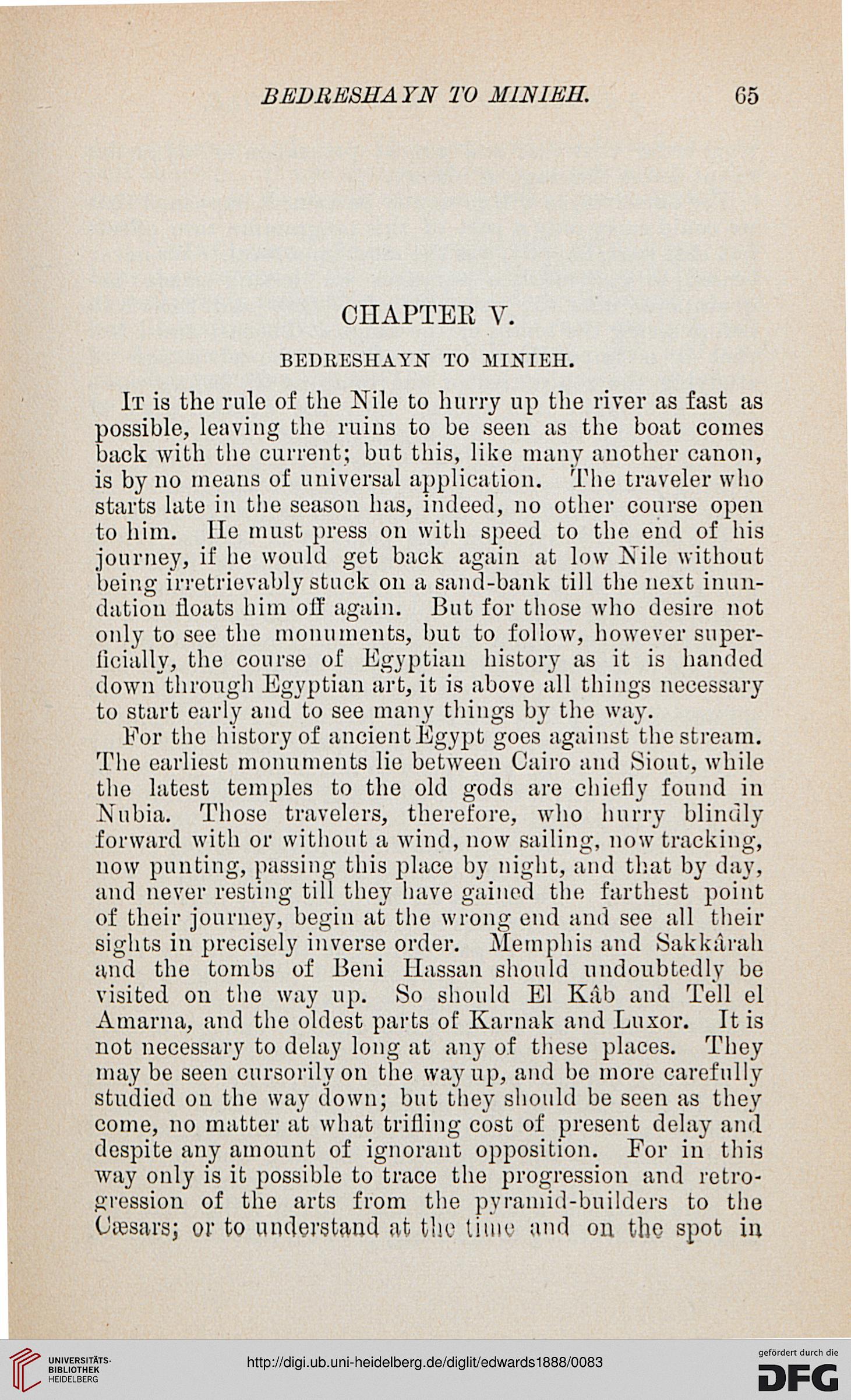BEDRESHAYN TO M1NIEU. G5
CHAPTER V.
BEDRESHAYN TO MINIEH.
It is the rule of the Nile to hurry up the river as fast as
possible, leaving the ruins to be seen as the boat comes
back with the current; but this, like many another canon,
is by no means of universal application. The traveler who
starts late in the season has, indeed, no other course open
to him. lie must press on with speed to the end of his
journey, if he would get back again at low Nile without
being irretrievably stuck on a sand-bank till the next inun-
dation floats him off again. But for those who desire not
only to see the monuments, but to follow, however super-
ficially, the course of Egyptian history as it is handed
down through Egyptian art, it is above all things necessary
to start early and to see many things by the way.
For the history of ancient Egypt goes against the stream.
The earliest monuments lie between Cairo and Siout, while
the latest temples to the old gods are chiefly found in
Nubia. Those travelers, therefore, who hurry blindly
forward with or without a wind, now sailing, now tracking,
now punting, passing this place by night, and that by day,
and never resting till they have gained the farthest point
of their journey, begin at the wrong end and see all their
sights in precisely inverse order. Memphis and Sakkarah
and the tombs of Beni Hassan should undoubtedly be
visited on the way up. So should El Kab and Tell el
Amarna, and the oldest parts of Karnak and Luxor. It is
not necessary to delay long at any of these places. They
may be seen cursorily on the way up, and be more carefully
studied on the way down; but they should be seen as they
come, no matter at what trilling cost of present delay ami
despite any amount of ignorant opposition. For in this
way only is it piossible to trace the progression and retro-
gression of the arts from the pyramid-builders to the
Uassarsj or to understand at the time and on the spot in
CHAPTER V.
BEDRESHAYN TO MINIEH.
It is the rule of the Nile to hurry up the river as fast as
possible, leaving the ruins to be seen as the boat comes
back with the current; but this, like many another canon,
is by no means of universal application. The traveler who
starts late in the season has, indeed, no other course open
to him. lie must press on with speed to the end of his
journey, if he would get back again at low Nile without
being irretrievably stuck on a sand-bank till the next inun-
dation floats him off again. But for those who desire not
only to see the monuments, but to follow, however super-
ficially, the course of Egyptian history as it is handed
down through Egyptian art, it is above all things necessary
to start early and to see many things by the way.
For the history of ancient Egypt goes against the stream.
The earliest monuments lie between Cairo and Siout, while
the latest temples to the old gods are chiefly found in
Nubia. Those travelers, therefore, who hurry blindly
forward with or without a wind, now sailing, now tracking,
now punting, passing this place by night, and that by day,
and never resting till they have gained the farthest point
of their journey, begin at the wrong end and see all their
sights in precisely inverse order. Memphis and Sakkarah
and the tombs of Beni Hassan should undoubtedly be
visited on the way up. So should El Kab and Tell el
Amarna, and the oldest parts of Karnak and Luxor. It is
not necessary to delay long at any of these places. They
may be seen cursorily on the way up, and be more carefully
studied on the way down; but they should be seen as they
come, no matter at what trilling cost of present delay ami
despite any amount of ignorant opposition. For in this
way only is it piossible to trace the progression and retro-
gression of the arts from the pyramid-builders to the
Uassarsj or to understand at the time and on the spot in




